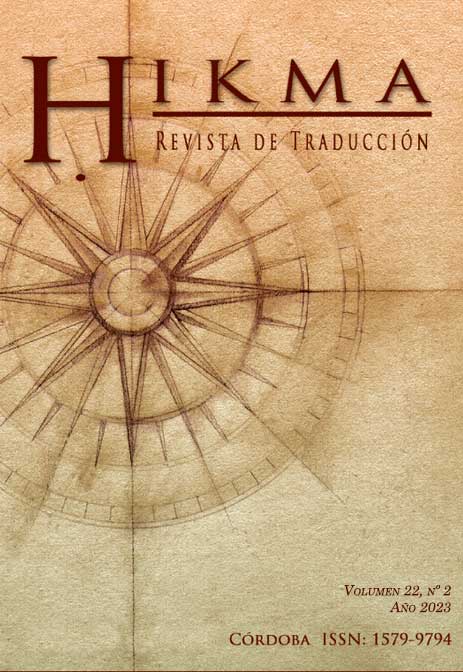Icons as a strategy to represent acoustic information in subtitles for the deaf and hard of hearing An experimental study about audience perception
Main Article Content
Abstract
In this experimental study we tested the acceptability and enjoyment of an alternative presentation of subtitles for the deaf and hard of hearing (SDH), using icons to represent paralinguistic information and sound effects. The consequent character reduction may allow more time for other aspects of viewing, like reading dialogue or the image. A total of 114 people with hearing impairment participated in the study. They were divided into a control group, where the respondents watched a video with traditional SDH, and an experimental group, where they watched our proposed alternative SDH. The results show that the use of icons did not increase the level of acceptability and enjoyment in comparison with traditional SDH, and that SDH with icons are more accessible for users of oral languages, who declared that icons contributed to a better understanding of the acoustic information. Even though verbal descriptions are broadly preferred, there is not a general rejection of the proposed SDH with icons. Additionally, data reveals that conveying acoustic information is highly valued by people with hearing impairment, even if it can be inferred from the image.
Downloads
Article Details

This work is licensed under a Creative Commons Attribution-NonCommercial-ShareAlike 4.0 International License.
Authors who publish with this journal agree to the following terms:
1. Authors retain copyright and grant the journal right of first publication with the work simultaneously licensed under a Creative Commons Attribution License that allows others to share the work with an acknowledgement of the work's authorship and initial publication in this journal.
2. Authors are able to enter into separate, additional contractual arrangements for the non-exclusive distribution of the journal's published version of the work (e.g., post it to an institutional repository or publish it in a book), with an acknowledgement of its initial publication in this journal.
3. Authors are permitted and encouraged to post their work online (e.g., in institutional repositories or on their website) prior to and during the submission process, as it can lead to productive exchanges, as well as earlier and greater citation of published work (See The Effect of Open Access).
References
AENOR. (2012). Norma UNE 153010: Subtitulado para personas sordas y personas con discapacidad auditiva. AENOR.
Arnáiz-Uzquiza, V. (2012). Subtitling for the deaf and the hard-of-hearing: some parameters and their evaluation [Tesis doctoral. Universitat Autònoma de Barcelona]. http://hdl.handle.net/10803/117528
CESyA. (2015). Seguimiento del subtitulado y la audiodescripción en la TDT. 2014. https://cesya.uc3m.es/recursos/CESyA
Civera, C. y Orero Clavero, P. (2010). Introducing icons in subtitles for the deaf and hard of hearing: optimising reception? En A. Matamala y P. Orero Clavero (Eds.), Listening to subtitles: subtitles for the deaf and hard of hearing (pp. 149-161). Peter Lang.
Fernández, L. (Prod.) y Caballero, P. (Dir.). (2019). Perdiendo el este (Cinta cinematográfica). Warner Bros Pictures, Atresmedia Cine, Producciones Aparte y Acosta Producciones Cinematográficas AIE.
FIAPAS. (2022). Plataformas digitales, televisiones de pago y otros servicios audiovisuales obligados a subtitular para personas con sordera. http://www.fiapas.es/actualidad-y-agenda/nota-informativa/plataformas-digitales-televisiones-de-pago-y-otros-servicios
Gambier, Y. (2018). Translation studies, audiovisual translation and reception. En E. Di Giovanni e Y. Gambier (Eds.), Reception studies and audiovisual translation (pp. 43-66). John Benjamins. DOI: https://doi.org/10.1075/btl.141.04gam
Grupo de trabajo de calidad de accesibilidad en la televisión. (2020). Propuesta de indicadores y métricas de subtitulado y audiodescripción en la TDT. https://www.siis.net/documentos/ficha/562688.pdf
Hernández Sampieri, R., Fernández Collado, C. y Baptista Lucio, P. (2010). Metodología de la investigación (5a ed.). McGraw-Hill.
Hersh, M. y Ohene-Djan, J. (2010). Representing contextual features of subtitles in an educational context. En J. Steimble (Ed.), 10th IEEE International Conference on Advanced Learning Technologies (pp. 714-715). IEEE Press. https://doi.org/10.1109/ICALT.2010.204 DOI: https://doi.org/10.1109/ICALT.2010.204
Ley 13/2022, de 7 de julio, General de Comunicación Audiovisual. Boletín Oficial del Estado, 63, de 8 de julio de 2022. https://www.boe.es/eli/es/l/2022/07/07/13/con
Mascow, J. (2015a). Long questionnaire in Germany. En P. Romero-Fresco (Ed.), The reception of subtitles for the deaf and hard of hearing (pp. 189-217). Peter Lang.
Mascow, J. (2015b). Eye tracking in Germany. En P. Romero-Fresco (Ed.), The reception of subtitles for the deaf and hard of hearing (pp. 313-335). Peter Lang.
Neves, J. (2005). Audiovisual Translation: subtitling for the deaf and hard-of-hearing [Tesis doctoral. Roehampton University]. https://pure.roehampton.ac.uk/ws/portalfiles/portal/427073/neves_audiovisual.pdf
Neves, J. (2009). Interlingual subtitling for deaf and hard-of-hearing. En J. Díaz Cintas y G. Anderman (Eds.), Audiovisual translation. language transfer on screen (pp. 151-169). Palgrave Macmillan. https://doi.org/10.1057/9780230234581_12 DOI: https://doi.org/10.1057/9780230234581_12
Reverter Oliver, B. (2019). Inclusión del alumnado con discapacidad sensorial y traducción audiovisual en las aulas de inglés de las EEOOII de la Comunitat Valenciana: un estudio exploratorio [Tesis doctoral. Universitat de València]. http://roderic.uv.es/handle/10550/72472
Rica Peromingo, J. (2019). Corpus lingüístico y tecnologías para la enseñanza, el aprendizaje y la investigación en traducción audiovisual y accesibilidad lingüística (subtitulado para sordos, audio descripción para ciegos y Lengua de Signos Española): normativas de aplicación. https://hdl.handle.net/20.500.14352/15017
Romero-Fresco, P. (2019). Accessible filmmaking. Routledge. DOI: https://doi.org/10.4324/9780429053771
Souto Rico, M. (2021). Estudio de la velocidad de los subtítulos para sordos en España y sus consecuencias normativas [Tesis doctoral. Universidad Carlos III de Madrid]. https://e-archivo.uc3m.es/handle/10016/32329
Tamayo Masero, A. (2015). Estudio descriptivo y experimental de la subtitulación en TV para niños sordos. Una propuesta alternativa [Tesis doctoral. Universitat Jaume I de Castellón]. https://www.tdx.cat/handle/10803/353962
Tamayo Masero, A., De los Reyes Lozano, J. y Martí Ferriol, J. L. (2021). Recepción de la subtitulación para personas sordas de los informativos españoles. Comunicación y Sociedad, 18, 1-22. https://doi.org/10.32870/cys.v2021.7875 DOI: https://doi.org/10.32870/cys.v2021.7875
Tsaousi, A. (2016a). Making sound accessible: the labelling of sound-effects in subtitling for the deaf and hard-of-hearing. Hermeneus, 17, 233-252. https://recyt.fecyt.es/index.php/HS/article/view/44973
Tsaousi, A. (2016b). Efecto de la modalidad de representación de los efectos sonoros en las preferencias de espectadores con diversidad auditiva. CoMe, I(1), 66-82. http://comejournal.com/wp-content/uploads/2019/06/7.-CoMe-I-1-2016.-Tsaousi.pdf
Tsaousi, A. (2018). El disfrute de la experiencia audiovisual por personas sordas y con diversidad auditiva: la representación visual de los efectos sonoros. Anuario Electrónico de Estudios en Comunicación Social «Disertaciones», 11(1), 110-126. https://doi.org/10.12804/revistas.urosario.edu.co/disertaciones/a.4982 DOI: https://doi.org/10.12804/revistas.urosario.edu.co/disertaciones/a.4982

